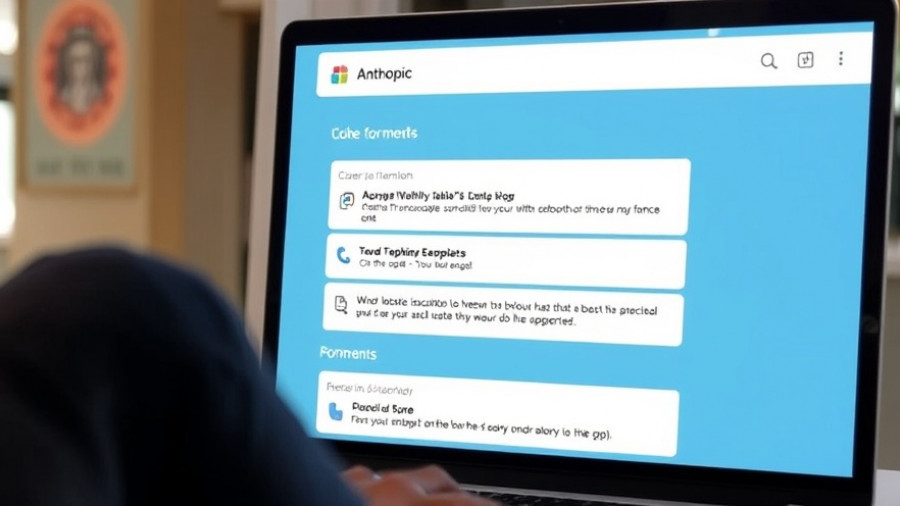
The Future of Cybersecurity: Claude Sonnet 4.5 Takes Center Stage
As technology continually evolves, so do the techniques used by cybercriminals. The rise of artificial intelligence (AI) has enabled attackers to automate and enhance their malicious activities, posing a significant threat to cybersecurity worldwide. This is where Anthropic’s new AI model, Claude Sonnet 4.5, enters the arena. Launched as a transformative tool for defending against sophisticated cyber threats, Claude 4.5 is being hailed as an inflection point in cybersecurity. It can identify, analyze, and fix vulnerabilities at significantly faster rates than traditional methods, which relied heavily on human intelligence.
Transitioning AI from Theory to Practice
Anthropic acknowledges a critical moment in cybersecurity history: the ability for AI to move from theoretical applications to practical, field-ready mechanisms. Previously, AI experiments revolved around identifying potential breaches. Now, Claude Sonnet 4.5 can not only recognize these vulnerabilities but also patch them proactively, marking a significant advancement from the laboratory to real-world applications. This shift means that the investment in developing AI capabilities can finally yield practical benefits in protecting vital code and infrastructure.
Performance Benchmarks: Outpacing Human Analysts
A pivotal aspect of Claude Sonnet 4.5's introduction is its performance in real-world simulation tests, such as Cybench and CyberGym. On Cybench, the AI model tackled 76.5% of challenges—a remarkable twofold improvement in just six months. This means complex tasks like decompiling malware or analyzing network traffic can now be accomplished at speeds previously thought unattainable. Its capabilities extend further; on CyberGym, it exposed vulnerabilities in two-thirds of tested software projects which previously went unnoticed. This level of efficiency positions Claude Sonnet 4.5 as an invaluable asset for cybersecurity professionals.
Successful Partnerships in Cyber Defense
Companies like HackerOne and CrowdStrike have swiftly integrated Claude Sonnet 4.5 into their security protocols. HackOne reported a 44% reduction in average vulnerability intake time with improved detection accuracy of 25%. This efficiency has transformed the speed and effectiveness of their security agents while simultaneously lowering risk. Furthermore, the model’s ability to simulate creative attacks provides an innovative approach for researchers to strengthen defenses across various platforms.
AI's Dual Role: A Positive Forces in Cybersecurity
Ironically, as AI advances defenses in cybersecurity, it can also be weaponized by attackers, as evidenced by Anthropic's disclosure about its own AI models being misused for nefarious purposes. This dichotomy underscores the pressing need for rapid advancements in defensive AI technologies like Claude Sonnet 4.5. As attackers adapt and evolve their strategies, an equal or greater response through AI defense is paramount to mitigating risks effectively.
Looking Ahead: A New Era of Cyber Defense
Anthropic remains focused on bolstering its defenses and refining Claude Sonnet 4.5 to address challenges faced by emerging threats. This proactive approach is crucial as cyber incidents become increasingly sophisticated. The emphasis on AI for cybersecurity signifies a trend towards smarter, more dynamic defense mechanisms that leverage machine learning to stay steps ahead of potential breaches. Observers ponder what this might mean for the future landscape of security in an era without precedent.
Conclusion: Why Knowing About Claude AI Matters
Understanding Claude Sonnet 4.5’s potential in cybersecurity enables organizations to strategize their defense mechanisms more effectively and adapt to an ever-evolving threat landscape. Keeping abreast of such innovations positions businesses not only as defenders against potential breaches but also as leaders in adopting advanced technological solutions that ensure critical infrastructures remain secure. Given the rapid advancements in AI, staying informed is crucial for those invested in safeguarding their digital environments.
 Add Row
Add Row  Add
Add 




Write A Comment